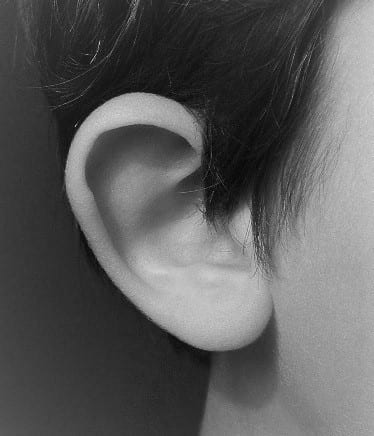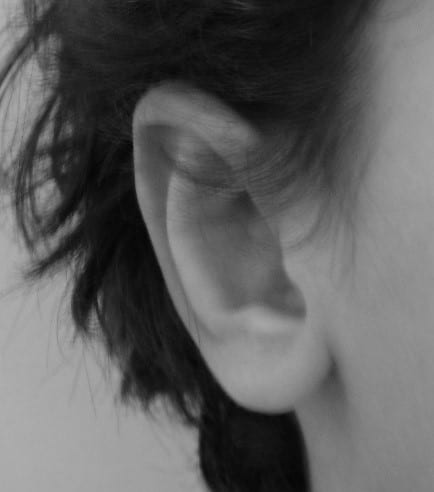Recovery from Stitch Otoplasty
Introduction
Otoplasty (correction of prominent ears) is the most common cosmetic surgical operation performed on the ear. Over the years the procedure has been refined so it has a quicker recovery with less down time. It is now performed under local anaesthetic (except in young children) without the need for bandages. The operation is very safe as the ear cartilage is manipulated from the back with stitches which eliminate any serious complications that can occur with more invasive techniques.


The terms stitch otoplasty or ear stitch are used to reflect the simpler approach. It is important to stress that despite its relative simplicity it should be performed by a surgeon who has an interest in ear surgery as the approach must be tailored to the individual depending on the elasticity and shape of the ear.
For Otoplasty the recovery period is relatively short. Patients can expect to return to daily activities / work within a few days without having to wear a bandage and children can return to school after a week. There are various stages in the complete recovery after an Otoplasty and these are best sub-divided into the following timeline:
- From surgery to Day 1
- Day 1 to Day 7
- Week 1 to Week 2
- Week 2 to Week 4
- Week 4 to Month 3
- Month 3 to Month 6
From Surgery to Day 1
The surgery is performed from the back of the ear with no skin removal necessary. The skin is closed with dissolvable stitches and immediately after surgery antibiotic ointment and a thin strip of wool are placed on the back of the ear. A soft bandage is placed around the ears whose aim is not to compress the ears but just to provide a secure a dressing for the first night and make the patient comfortable. The ears will continue to be numb after surgery as the effect of the local anaesthetic would still be ongoing. This lasts for approximately one hour after which localised pain around the ears will be felt. Pain killers are given prior to discharge. I prefer to give co-codamol (paracetamol plus codeine) initially. This is then changed to paracetamol after about 2 days. The patient is advised to take pain killers regularly, sleep on his / her back for the first night and to slightly elevate the head.
From Day 1 to Day 7
The bandage is removed the next day after surgery. There will be some swelling to the ears although there is usually minimal visible bruising as the procedure is performed from the back of the ear. Pain around the ears is likely to be present during this period and the patient is advised to continue with regular co-codamol or paracetamol. There are no visible stitches from the front. Patients can resume many gentle daily activities from day 1 after surgery. It is even possible to do light work or return to the office within 2-3 days. It is normal for the ears to feel numb to touch at this stage.
The thin wool which was placed at the time of surgery behind the ear should stay on without the bandage. This covers the wound and therefore the patient is not required to do any change of dressing. If the wool behind the ears falls off then the patient is advised to gently wipe the wound with sterile saline and gauze (provided) every 1-2 days.
The patient is asked to avoid washing the hair and to wear a soft band at night to protect the ears. During the day a head band is not necessary but some patients may prefer to wear one as it gives a secure comfortable feeling. Towards the end of this period the pain will significantly subside.
Week 1 to Week 2
After the first week patients are allowed to shower the head as normal, preferably with a gentle shampoo. Pain should have resolved at this stage but the ears will be tender to touch. Patients should be able to comfortably return to work after the first week and children can safely go back to school. Specific advice will need to be given to children regarding playing and sports. There will still be mild swelling to the ears at this point and the ears will feel numb.
A soft head band is recommended to be worn at night to protect the ear during this week. During the day it is not necessary but may be preferable for children as they are accident prone or in adults if they are in a dusty environment. This can be removed as needed.
Week 2 to Week 4
Most of the swelling resolves during this period. The ears will not be painful but continue to be tender to touch with numbness which differs in patients. A head band is not required during the day but it is advisable at night to protect the ears. Patients are able to carry out all their daily activities but return to vigorous physical activity / sports should be gradual (see below section on physical activity).
The dissolvable skin stitches behind the ear fall off around week 3 and the surgical scar, which is not visible from the front, will be red at this stage. It is advisable not to enter a swimming pool till after week 4.
Week 4 to 3 months
Nearly all the swelling should resolve during this phase of healing. The ears may still feel tender to firm touch and there will still be some numbness at this stage. All aspects of daily life should have returned to normal. Sport activities can be increased back towards pre-surgical levels. Care will still need to be taken in contact sports.
3 Months to 6 Months
During this period any remaining swelling should fully resolve and the ears regain normal sensation. Very minor tenderness to touch (not pain) can persist up to 6 months. The red scar will become paler and by 6 months is usually only visible on close inspection. By the end of this period full recovery should have occurred.
Physical activity and Sport
Most of physical activities that involve no contact can be resumed after the second week although less vigorously. These include jogging, cycling and gym. Such activities would not affect the healing or the surgical outcome however strenuous exercise may increase swelling to the ears and patients are advised not to return to their pre-operative level till 4 weeks have passed. Swimming in the pool / sea should be avoided in the first 3 weeks to avoid exposure to any bacteria whilst the ear is healing.
Special precautions would need to be taken for contact sports such as football and rugby. Competitive football can re-start after 4 weeks and rugby after 6 weeks and it would be prudent to protect the ears with a sport headband or a rugby cap for up to 3 months. Sports that involve more significant contact and possible blows to the ears, such as boxing and martial arts, a delay of 3 months from surgery is recommended and the ears should be protected for up to 6 months.
